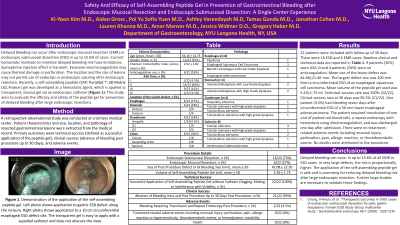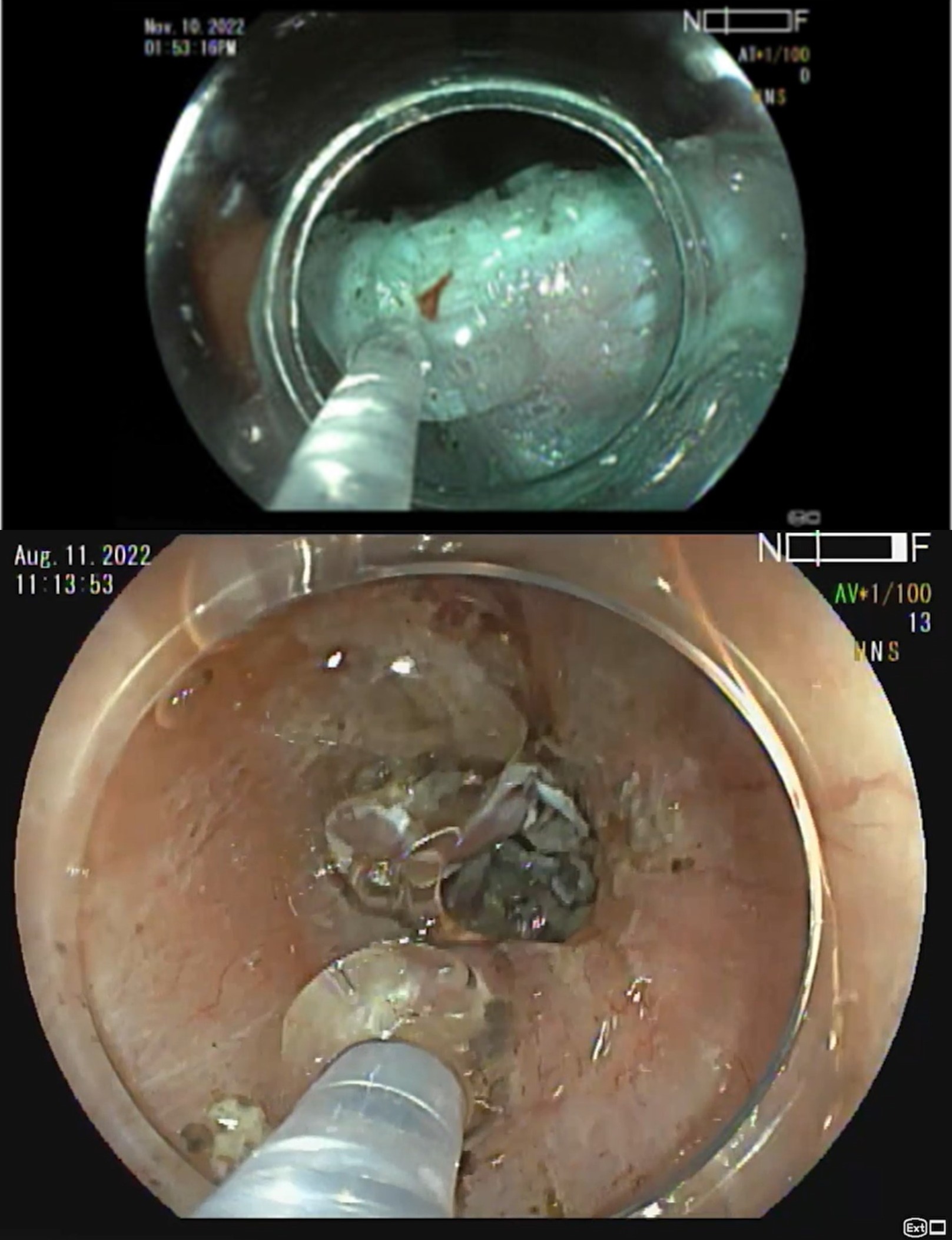Tuesday Poster Session
Category: Interventional Endoscopy
P3706 - Safety and Efficacy of Self-Assembling Peptide Gel in Prevention of Gastrointestinal Bleeding After Endoscopic Mucosal Resection and Endoscopic Submucosal Dissection: A Single Center Experience
Tuesday, October 24, 2023
10:30 AM - 4:00 PM PT
Location: Exhibit Hall

Has Audio
- KK
Ki-Yoon Kim, MD
NYU Langone
New York, NY
Presenting Author(s)
Ki-Yoon Kim, MD1, Aidan Gross, 1, Sofia Yuen, MD1, Ashley Vareedayah, MD1, Tamas Gonda, MD2, Jonathan Cohen, MD1, Lauren Khanna, MD1, Amar Manvar, MD3, Jessica Widmer, MD4, Gregory Haber, MD5
1NYU Langone, New York, NY; 2NYU Grossman School of Medicine, New York, NY; 3NYU Long Island, Mineola, NY; 4NYU Long Island, New York, NY; 5NYU, New York, NY
Introduction: Delayed bleeding can occur after endoscopic mucosal resection (EMR) or endoscopic submucosal dissection (ESD) in up to 15.6% of cases. Current hemostatic methods to minimize delayed bleeding risk have limitations. Epinephrine injection effect is transient. Excessive electrocoagulation may cause thermal damage or perforation. The location and the size of lesions may not permit use of endoclips or endoscopic suturing after endoscopic resection. Recently, a self-assembling peptide (SAP; Purastat) gel was developed as a hemostatic agent, which is applied as transparent, viscous gel via an endoscopic catheter (Figure 1). This study aims to evaluate the efficacy and safety of the peptide gel for prevention of delayed bleeding after large endoscopic resections.
Methods: A retrospective observational study was conducted at a tertiary medical center. Patient characteristics and size, location, and pathology of resected gastrointestinal lesions were extracted from the medical record. Primary outcomes were technical success (defined as successful application of the peptide gel), clinical success (absence of bleeding post procedure up to 30 days), and adverse events.
Results: 22 patients were included with follow up of 30 days. There were 16 ESD and 6 EMR cases. Baseline clinical and technical data are reported in Table 1. 9 patients (36%) were ASA III and 4 patients (16%) were on anticoagulation. Mean size of the lesion defect was 44.66+21.46 mm. The largest defect size was 100 mm from a circumferential ESD of an esophageal squamous cell carcinoma. Mean volume of the peptide gel used was 5.43+1.73 ml. Technical success rate was 100% (22/22). Clinical success rate at 30 days was 95.5% (21/22). One patient (4.5%) had bleeding seven days after circumferential ESD of a 50 mm lower esophageal adenocarcinoma. The patient required transfusion of one unit of packed red blood cells, a repeat endoscopy with hemostasis using electrocoagulation, and was discharged one day after admission. There were no treatment-related adverse events including mucosal injury, perforation, pain, allergic reaction, or thromboembolic events. No deaths were attributed to the procedure.
Discussion: Delayed bleeding can occur in up to 15.6% of all EMR or ESD cases. In very large defects, the risk is proportionally higher. The application of the self-assembling peptide gel is safe and is promising for reducing delayed bleeding risk after large endoscopic resection. Further large studies are necessary to validate these findings.

Disclosures:
Ki-Yoon Kim, MD1, Aidan Gross, 1, Sofia Yuen, MD1, Ashley Vareedayah, MD1, Tamas Gonda, MD2, Jonathan Cohen, MD1, Lauren Khanna, MD1, Amar Manvar, MD3, Jessica Widmer, MD4, Gregory Haber, MD5. P3706 - Safety and Efficacy of Self-Assembling Peptide Gel in Prevention of Gastrointestinal Bleeding After Endoscopic Mucosal Resection and Endoscopic Submucosal Dissection: A Single Center Experience, ACG 2023 Annual Scientific Meeting Abstracts. Vancouver, BC, Canada: American College of Gastroenterology.
1NYU Langone, New York, NY; 2NYU Grossman School of Medicine, New York, NY; 3NYU Long Island, Mineola, NY; 4NYU Long Island, New York, NY; 5NYU, New York, NY
Introduction: Delayed bleeding can occur after endoscopic mucosal resection (EMR) or endoscopic submucosal dissection (ESD) in up to 15.6% of cases. Current hemostatic methods to minimize delayed bleeding risk have limitations. Epinephrine injection effect is transient. Excessive electrocoagulation may cause thermal damage or perforation. The location and the size of lesions may not permit use of endoclips or endoscopic suturing after endoscopic resection. Recently, a self-assembling peptide (SAP; Purastat) gel was developed as a hemostatic agent, which is applied as transparent, viscous gel via an endoscopic catheter (Figure 1). This study aims to evaluate the efficacy and safety of the peptide gel for prevention of delayed bleeding after large endoscopic resections.
Methods: A retrospective observational study was conducted at a tertiary medical center. Patient characteristics and size, location, and pathology of resected gastrointestinal lesions were extracted from the medical record. Primary outcomes were technical success (defined as successful application of the peptide gel), clinical success (absence of bleeding post procedure up to 30 days), and adverse events.
Results: 22 patients were included with follow up of 30 days. There were 16 ESD and 6 EMR cases. Baseline clinical and technical data are reported in Table 1. 9 patients (36%) were ASA III and 4 patients (16%) were on anticoagulation. Mean size of the lesion defect was 44.66+21.46 mm. The largest defect size was 100 mm from a circumferential ESD of an esophageal squamous cell carcinoma. Mean volume of the peptide gel used was 5.43+1.73 ml. Technical success rate was 100% (22/22). Clinical success rate at 30 days was 95.5% (21/22). One patient (4.5%) had bleeding seven days after circumferential ESD of a 50 mm lower esophageal adenocarcinoma. The patient required transfusion of one unit of packed red blood cells, a repeat endoscopy with hemostasis using electrocoagulation, and was discharged one day after admission. There were no treatment-related adverse events including mucosal injury, perforation, pain, allergic reaction, or thromboembolic events. No deaths were attributed to the procedure.
Discussion: Delayed bleeding can occur in up to 15.6% of all EMR or ESD cases. In very large defects, the risk is proportionally higher. The application of the self-assembling peptide gel is safe and is promising for reducing delayed bleeding risk after large endoscopic resection. Further large studies are necessary to validate these findings.

Figure: Figure 1. Demonstration of the application of the self-assembling peptide gel (PuraStat ®; 3D Matrix Ltd, France). In the top photo, the peptide gel is applied to a gastric ESD defect along the incisura. In the bottom photo, the peptide gel is applied to a 10 cm circumferential esophageal ESD defect site. The transparent gel is easy to apply with a supplied catheter and does not obscure the view.
Disclosures:
Ki-Yoon Kim indicated no relevant financial relationships.
Aidan Gross indicated no relevant financial relationships.
Sofia Yuen indicated no relevant financial relationships.
Ashley Vareedayah indicated no relevant financial relationships.
Tamas Gonda indicated no relevant financial relationships.
Jonathan Cohen: GI Windows – Stock-privately held company. MD Medical Navigators – Owner/Ownership Interest. Micro-tech – Consultant. olympus america, inc – Consultant. ROM-tech – Stock-privately held company. Virtual Health Partners – Stock-privately held company. wiley – Royalties. Wolters-Kluwer – Royalties.
Lauren Khanna indicated no relevant financial relationships.
Amar Manvar indicated no relevant financial relationships.
Jessica Widmer: Boston Scientific – Consultant.
Gregory Haber: BSC – Consultant. Digma – Consultant. Erbe – Consultant. Medtronic – Consultant. Microtech – Consultant. Olympus – Consultant. Ovesco – Consultant.
Ki-Yoon Kim, MD1, Aidan Gross, 1, Sofia Yuen, MD1, Ashley Vareedayah, MD1, Tamas Gonda, MD2, Jonathan Cohen, MD1, Lauren Khanna, MD1, Amar Manvar, MD3, Jessica Widmer, MD4, Gregory Haber, MD5. P3706 - Safety and Efficacy of Self-Assembling Peptide Gel in Prevention of Gastrointestinal Bleeding After Endoscopic Mucosal Resection and Endoscopic Submucosal Dissection: A Single Center Experience, ACG 2023 Annual Scientific Meeting Abstracts. Vancouver, BC, Canada: American College of Gastroenterology.
